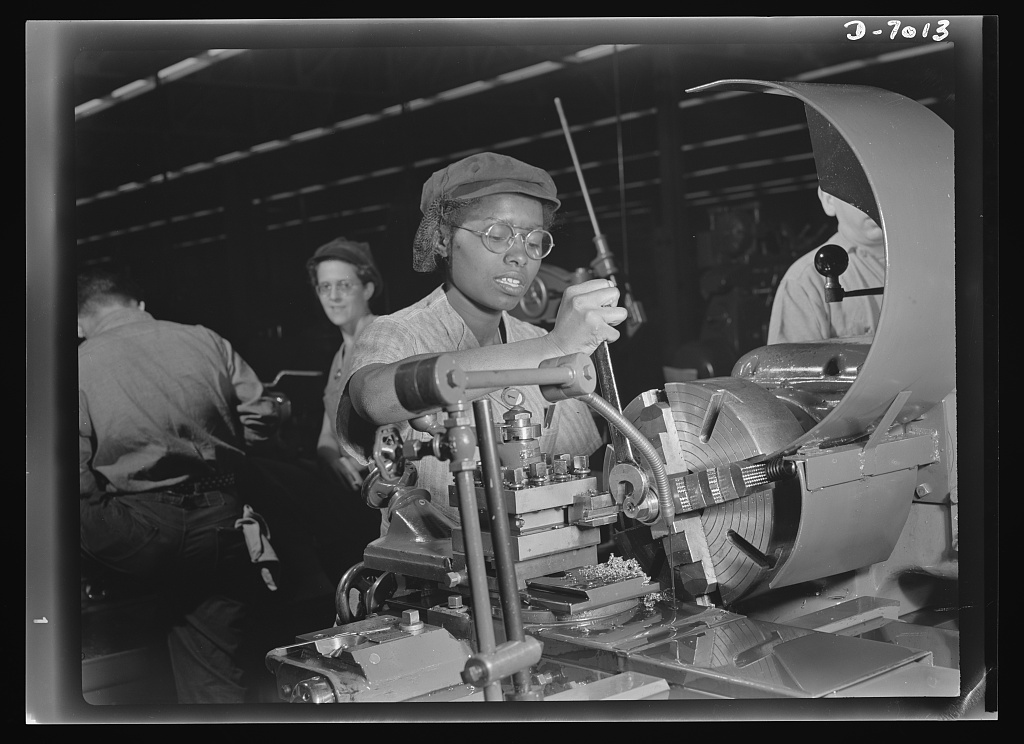Source: Elinor Florence
Today’s, Vintage Photo Tuesday, are wartime photos of women doing their part during WW2. This is not a new topic for me as I have shared posts on the home front effort many times before (see end of post) but I really wanted to do it again to stress how important it is to “Do Your Part”. For us in 2020 that means just staying home. For the ladies (and of course the men) during WW2 it meant leaving the home and heading into factories, hospitals and overseas.
Let’s take a look at this weeks photos….
Vintage Photos of the Women of World War 2
Helping with the War Effort
1940s Photo of a women working in a WW2 Factory. This is Miss Elsie Richards of Bulladelah, who assisted her parents in the running of a store, now she machines the copper driving band of 25 pounder shells.
Source: Flickr
Willa Beatrice Brown (January 22, 1906 – July 18, 1992) was an American aviator, lobbyist, teacher, and civil rights activist.
She was the first African-American woman to earn her pilot’s license in the United States, the first African-American woman to run for the United States Congress, the first African-American officer in the US Civil Air Patrol, and the first woman in the United States to have both a pilot’s license and a mechanic’s license.
A lifelong advocate for gender and racial equality in flight and in the military, Brown not only lobbied the U.S. government to integrate the U.S. Army Air Corp and include African Americans in the Civilian Pilot Training Program (CPTP), but also co-founded the Cornelius Coffey School of Aeronautics with Cornelius Coffey, which was the first private flight training academy in the United States owned and operated by African Americans.
She trained hundreds of pilots, several of whom would go on to become Tuskegee Airmen (Source). YES!!!!
Source: Wikipedia
1940s Photo: View of the main operations room shows mostly women volunteers “plotting” the position of the Victoria Air Sector, 25 aircraft aloft at the time.
Source: Flickr
1944 Photo of Sergeant Karen M. Hermiston of the Canadian Women’s Army Corps, holding a Rolleiflex camera.
Source: Flickr
U.K. Women carpenters, 1941 photo. 16 year old Stella Day drills a hole in a wooden beam during the production of huts at this workshop, somewhere in England, 1941. According to the original caption, Miss Day’s father is a Petty Officer in the Royal Navy.
Source: Imperial War Museum
Los Angeles, Calif. — Miss Ethel Mildred Lee, 23-year-old girl born in this country of Chinese parents, is shown at her job as an electrician-helper at the Los Angeles yards of the California Shipbuilding Corporation, where she has worked for almost two years.
Extra incentives to help the war effort are two brothers in the U.S. Army and one in the Navy yard at Honolulu, Hawaii. Miss Lee, who’s 4 feet 10 inches tall and weighs 98 pounds, buys $100 worth or War Bonds a month. — January 20, 1944
Source: Tumblr
Two Army nurses sit on the steps at Cape Gloucester, New Britain in August 1944.
Source: Digital Collections of the National WW2 Museum
1940s Photo of a young Black woman working on a machine in a factory. According to the Library of Congress, “Plant foremen point to 20-year-old Annie Tabor as one of their best lathe operators, despite her lack of previous industrial experience.”
Source: Buzzfeed
ATS anti-aircraft artillery spotters learn to use an identification telescope at No.7 ATS Training Centre at Stoughton near Guildford, 24 September 1941.
Source: Imperial War Museum
1940s Photo of a Women Ordnance Worker (WOWs) during World War II. Wartime posters celebrating these women, who worked in war plants making weapons, ammunition, and other military supplies. The most famous WOW was Rosie the Riveter.
Source: Tumblr
“The WOW bandana, designed in accordance with U.S. Army specifications, is an attractive, safe, and unifying head covering to identify women ordnance workers. About 27” square, it is available either in ordnance red with white ordnance insignia, or in white with red ordnance insignia. Every woman in your plant will want one – it’s a “WOW” for morale!“ (Ad, 1943).
The head scarf with flaming bomb designs became the symbol of women working in war industries (Source).
Source: Tumblr
Here are other posts on Women on the Home Front that you should check out, as we near the end of Women’s History Month:
World War 2 Women’s Contributions & Homefront Posts
Hope everyone is doing well and keeping safe!
Liz












